Parareptiles (and other basal reptiles)
|
The parareptiles are a basal (early branch) of the reptile tree and are now extinct. They are characterized by having an apapsid skull (no openings in the skull roof behind the orbit), but are otherwise quite diverse.
Scutosaurus karpinskii, such as this skeleton cast of a juvenile individual, were large cow-sized herbivores with dermal (skin) armor.
Taxonomy: Sauropsida (Reptilia); Parareptilia†; Pareiasauria; Pareiasauridae
Northern European Russia
Late Permian Period, 260 Ma
Arizona Museum of Natural History
|

|
|
|
Reconstructed skeleton of Bradysaurus baini, a close relative of Scutosaurus.
Taxonomy: Sauropsida (Reptilia): Parareptilia†; Pareiasauria; Pareiasauridae
South Africa
Late Permian Period, 265-260 Ma
Field Museum, Chicago
|
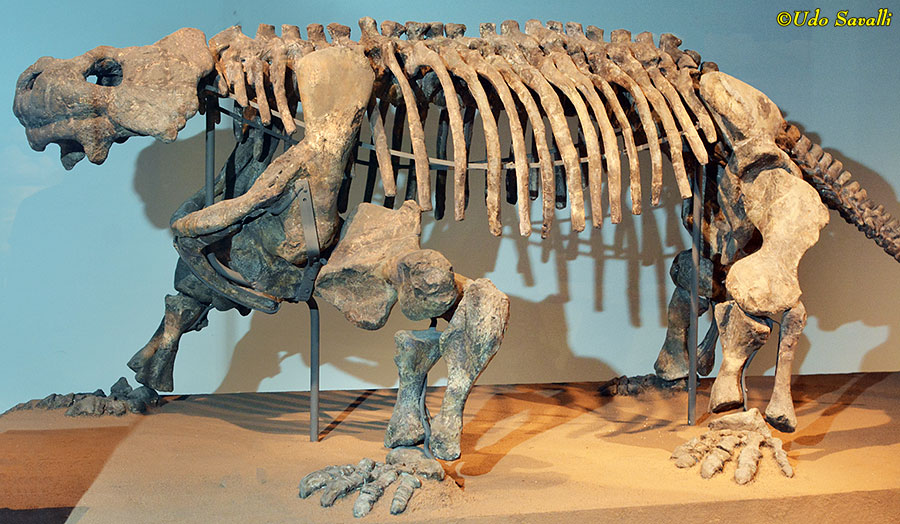
|
|
|
Mesosaurs are another subgroup of parareptiles and were very different from the paraeiasaurs such as Scutosaurus. They were elongated, semi-aquatic swimmers with long snouts lined with many delicate teeth that may have functioned as filter-feeding baskets. This fossil is of Stereosternum sp.
Taxonomy: Sauropsida (Reptilia); Parareptilia; Mesosauridae
Brazil
Permian Period
Black Hills Institute Museum, South Dakota
|

|
|
|
Mesosaurus tenuidens is associated with fresh water and its distribution in the sourthern hemisphere has been used as evidence for continental drift.
Taxonomy: Sauropsida (Reptilia); Parareptilia; Mesosauridae
South America
Early Permian Period, 290 Ma
Wyoming Dinosaur Center
|

|
|
|
Life model of a Procolophonid, a lizard-like parareptile.
Taxonomy: Sauropsida (Reptilia); Parareptilia; Procolophonidae
Late Triassic Period, 225 Ma
Arizona Museum of Natural History
|

|
|
|
Captorhinus aguti skeleton. Captorhinus is a basal reptile but it is a separate branch apart from the parareptiles. It was a lizard-like predator.
Taxonomy: Sauropsida (Reptilia); Captorhinidae
Oklahoma
Permian Period
Field Museum, Chicago
|
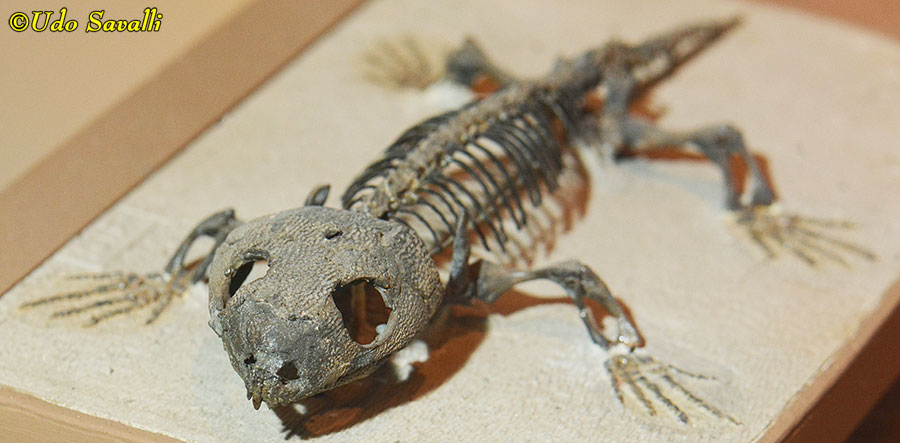
|
|
|
Captorhinus aguti skull and associated bones.
Taxonomy: Sauropsida (Reptilia); Captorhinidae
El Reno Group; Oklahoma
early Permian Period
Museum of Ancient Life, Utah
|

|
|
|
Labidosaurus hamatus skeleton. This early reptile is related to Captorhinus, but was probably omnivorous.
Taxonomy: Sauropsida (Reptilia); Captorhinidae
Texas
Early Permian Period
Field Museum, Chicago
|
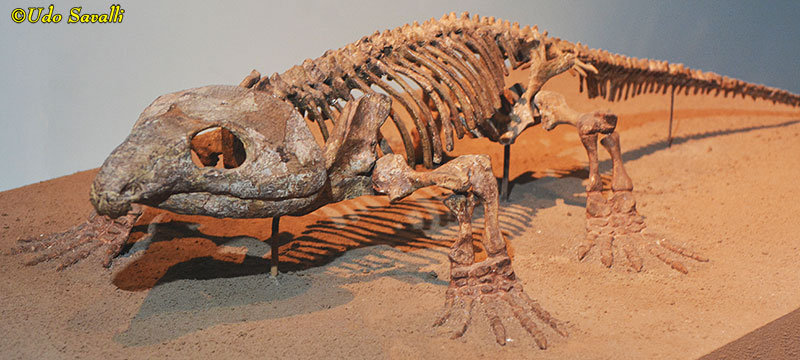
|
|
|
Protorothyris archeri skull cast. This is another small branch of the early reptile tree.
Taxonomy: Sauropsida (Reptilia); Protorothyrididae
Texas
Early Permian Period
Field Museum, Chicago
|
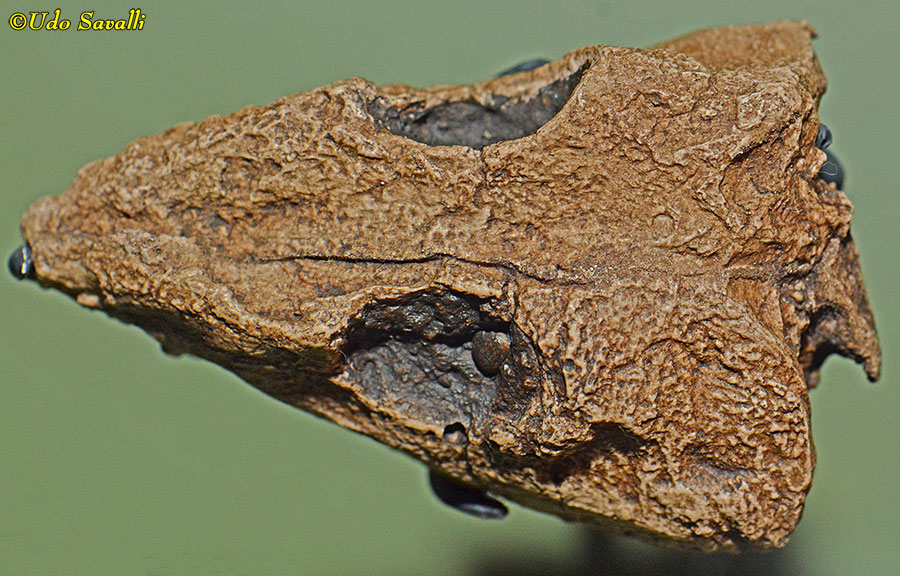
|
|
|
Life model of Hylonomus sp., a basal reptile. Note its generally lizard-like apprearance. It is probably related to Protorothyris (above).
Taxonomy: Sauropsida (Reptilia); Captorhinida; Protorothyrididae
Carboniferous Period, Pennsylvanian Epoch, 312 Ma; Canada
Museum of Ancient Life, Utah
|

|
|
|
Cast of a Youngina romeri skull. Note the two openings behind each of the large orbits (eye sockets): these indicate that this animal was an early Diapsid, the clade to which all extant reptiles belong
Taxonomy: Sauropsida (Reptilia); Captorhinida; Protorothyrididae
South Africa
Permian Period
Field Museum, Chicago
|
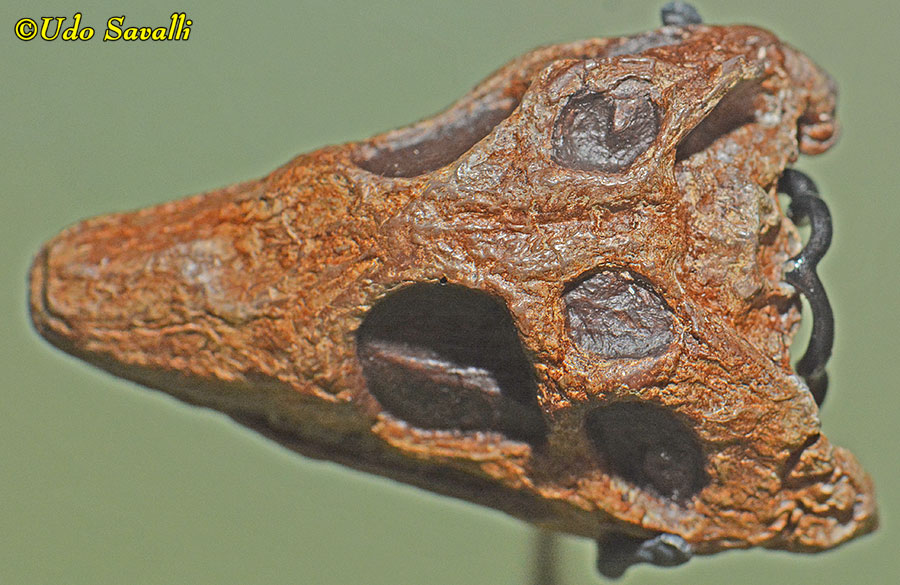
|
|
Lepidosaurs
|
Lepidosaurs include the modern squamates (lizards & snakes) and the rhynchocephalians (the tuatara). Rhynchocephalians are superficially lizard-like, although they have a more primitive skull.
Some were semiaquatic, such as this Pleurosaurus goldfussi.
Taxonomy: Sauropsida (Reptilia); Lepidosauria; Rhynchocephalia; Pleurosauridae
Solnhofen Limestone, Germany
Late Jurassic Period, 150 Ma
Wyoming Dinosaur Center
|

|
|
Life model of Opisthias rarus.This species looks very similar to the modern tuatara.
Taxonomy: Sauropsida (Reptilia); Lepidosauria; Rhynchocephalia; Opisthodontia
Morrison Formation, Western North America
Late Jurassic Period
Arizona Museum of Natural History
|

|
|
|
The Squamata are the lizards and snakes, a successful group of vertebrates that survive to this day. This unidentified lizard is missing some of its legs but has preserved skin impressions showing its scales.
Taxonomy: Sauropsida (Reptilia); Lepidosauria; Squamata
Green River Formation, UT
Eocene Epoch
Black Hills Institute Museum, South Dakota
|

|
|
|
Fossil of the lizard Afairiguana avius . This specimen is the holotype (the specimen that represents and identifies this species).
Taxonomy: Sauropsida (Reptilia); Lepidosauria; Squamata; Polychrotidae
Fossil Lake, WY
Eocene Epoch
Field Museum, Chicago
|
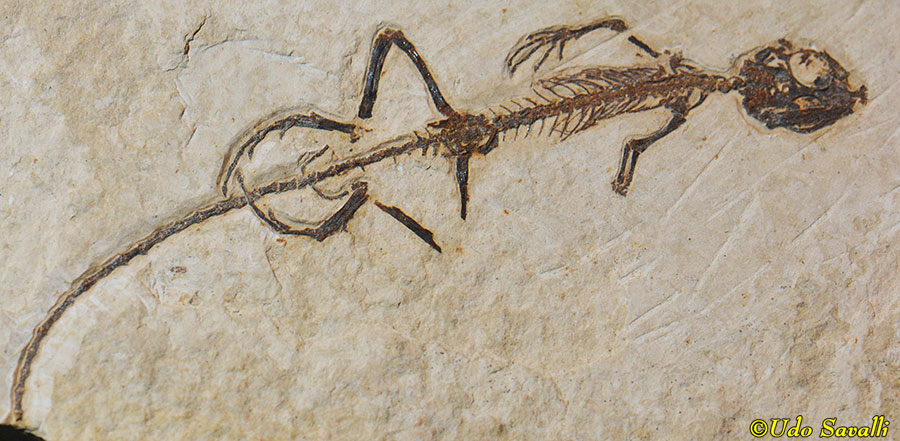
|
|
|
The skull of the lizard Peltosaurus sp. Lizard and snake skulls are generally quite delicate since many bones have some ability to move relative to one another.
Taxonomy: Sauropsida (Reptilia); Lepidosauria; Squamata; Anguidae
North America
Eocene to Oligocene
Black Hills Institute Museum, South Dakota
|

|
|
|
Fossil of the monitor lizard Saniwa ensidens.
Taxonomy: Sauropsida (Reptilia); Lepidosauria; Squamata ; Varanidae
Fossil Lake, WY
Eocene Epoch
Field Museum, Chicago
|

|
|
|
The megalania, Varanus prisca, is the largest terrestrial lizard ever. It is a varanid (monitor lizard), a cousin of the modern Komodo Dragon. Cast of skull.
Taxonomy: Sauropsida (Reptilia); Lepidosauria; Squamata; Varanidae
Australia
Pleistocene Epoch
San Diego Natural History Museum
|

|
|
|
Life model of Paleosaniwa sp., a close relative of modern monitor lizards, shown raiding a dinosaur nest.
Taxonomy: Sauropsida (Reptilia); Lepidosauria; Squamata; Varanidae
Late Cretaceous Period
Arizona Museum of Natural History
|

|
|
|
Life model of a Polyglyphanodontian lizard.
Taxonomy: Sauropsida (Reptilia); Lepidosauria; Squamata; Polyglyphanodontia†
Arizona
Late Cretaceous Period
Arizona Museum of Natural History
|

|
|
|
Snakes are a specialized group of lizards that have lost their limbs, their eyelids are fused to their eyes, and have a forked tongue. Snakes originated in the Cretaceous, such as this Pachyophis woodwardi. Although this species lacks limbs, it is related to species that still had vestigial hind limbs.
Taxonomy: Sauropsida (Reptilia); Lepidosauria; Squamata; Serpentes
Europe
late Cretaceous Period, 99-93 Ma
Fernbank Museum of Natural History, Georgia
|

|
|
Mosasaurs
|
Although mosasaurs are just lizards, they are sufficiently distinctive and were important in marine environments during the late Cretaceous Period, so we will treat them separately here. Mosasaurs were fully aquatic marine reptiles with their limbs developed into flippers.
This is a skeleton of Halisaurus sp.
Taxonomy: Sauropsida (Reptilia); Lepidosauria; Squamata; Mosasauridae
North America
Late Cretaceous Period, 69 Ma
Wyoming Dinosaur Center
|

|
|
|
Tylosaurus proriger was one of the largest mosasaurs, reaching 14 m in length.
Taxonomy: Sauropsida (Reptilia); Lepidosauria; Squamata; Mosasauridae
North America, New Zealand
Late Cretaceous Period, 88-81 Ma
Museum of Ancient Life, Utah
|

|
|
|
Tylosaurus nepaeolicus, still in plaster jacket.
Taxonomy: Sauropsida (Reptilia); Lepidosauria; Squamata; Mosasauridae
Niobrara Chalk, Lane Co., Kansas
Late Cretaceous Period, 85 Ma
Dinosaur Resource Center, Colorado
|

|
|
|
Clidastes propython was one of the smallest species of mosasaur, around 2-4 m long.
Taxonomy: Sauropsida (Reptilia); Lepidosauria; Squamata; Mosasauridae
Niobrara Chalk, Great Plains
Late Cretaceous Period, 70 Ma
Museum of Ancient Life, Utah
|

|
|
|
Mosasaurs, such as this Plotosaurus bennisoni, can be distinguished from other marine reptiles by their proportionately larger front flippers and their elongated body and long tail (compare with plesiosaurs).
Taxonomy: Sauropsida (Reptilia); Lepidosauria; Squamata; Mosasauridae
California
Late Cretaceous Period, 67-66 Ma
Los Angeles Museum of Natural History
|

|
|
|
Plesioplatecarpus planifrons .
Taxonomy: Sauropsida (Reptilia); Lepidosauria; Squamata; Mosasauridae
Niobrara Chalk, Kansas
Late Cretaceous Period, 85 Ma
Dinosaur Resource Center, Colorado
|

|
|
|
Platecarpus corphaeus.
Taxonomy: Sauropsida (Reptilia); Lepidosauria; Squamata; Mosasauridae
Niobrara Formation, Trego Co., Kansas
Late Cretaceous Period, 85 Ma
Denver Museum of Science & Nature
|

|
|
|
Mosasaurs were predators, feeding on fish or other marine reptiles. This is a Platecarpus tympaniticus skull fossil.
Taxonomy: Sauropsida (Reptilia); Lepidosauria; Squamata; Mosasauridae
Kansas
Late Cretaceous Period, 87-82 Ma
Los Angeles Museum of Natural History
|

|
|
|
Life model of a Platecarpus sp. mosasaur.
Taxonomy: Sauropsida (Reptilia); Lepidosauria; Squamata; Mosasauridae
Late Triassic Period; Location
New Mexico Museum of Natural History & Science
|

|
|
|
Tethysaurus nopscai had some characteristics that suggested it was intermediate between derived mosasaurs and their semiaquatic ancestors.
Taxonomy: Sauropsida (Reptilia); Lepidosauria; Squamata; Mosasauridae
Morocco
Late Cretaceous Period, 69 Ma
Wyoming Dinosaur Center
|

|
|
|
Aigialosaurus sp. was a semi-aquatic lizard that was ancestral to the mosasaurs.
Taxonomy: Sauropsida (Reptilia); Lepidosauria; Squamata; Aigialosauridae
Goulmima, Morocco
Late Cretaceous Period, Turonian Stage
Black Hills Institute Museum, South Dakota
|

|
|
Stem Archosaurs
(Non-archosaur Archosauromorphs)
|
The Choristodera are a clade of semi-aquatic reptiles more closely related to the Archosaurs than the Lepidosaurs. Champsosaurus laramiensis was a semi-aquatic fish eater that superficially resembled a small (1.5m crocodile).
Taxonomy: Sauropsida (Reptilia); Archosauromorpha; Choristodera; Champsosauridae
Hell Creek Formation, Harding Co., South Dakota
Late Cretaceous Period, 66 Ma
Dinosaur Resource Center, Colorado
|

|
|
|
Champsosaurus sp. skull cast.
Taxonomy: Sauropsida (Reptilia); Archosauromorpha; Choristodera; Champsosauridae
Hell Creek Formation, western USA
Late Cretaceous Period, 66 Ma
Black Hills Institute Museum, South Dakota
|

|
|
|
In addition to crocodile-like forms such as Champsosaurus, some Choristoderes were long-necked swimmers such as this Hyphalosaurus lingyuanensis that have evolved a body plan convergent with nothosaurs
Taxonomy: Sauropsida (Reptilia); Archosauromorpha; Choristodera; Hyphalosauridae
Yixian Formation, Liaoning Prov, China
Early Cretaceous Period, 122 Ma
Black Hills Institute Museum, South Dakota
|

|
|
|
Life model of Hyphalosaurus lingyuanensis.
Taxonomy: Sauropsida (Reptilia); Archosauromorpha; Choristodera; Hyphalosauridae
Early Cretaceous Period, 130-125 Ma; China
Fernbank Museum of Natural History, Georgia
|

|
|
|
Life model of Monjurosuchus splendens.
Taxonomy: Sauropsida (Reptilia); Archosauromorpha; Choristodera; Monjurosuchidae
Early Cretaceous Period, 130-125 Ma; China
Fernbank Museum of Natural History, Georgia
|

|
|
|
The Prolacertiforma is a clade of small, mostly lizard-like tree-climbers. One species (known from only 1 specimen), Sharovipteryx mirabilis, had membranes on very elongated hind limbs suggesting it could glide.
Taxonomy: Sauropsida (Reptilia); Archosauromorpha; Prolacertiformes; Sharovipterygidae
Kyrgyzstan
Mid-Triassic Period, 225 Ma
Arizona Museum of Natural History
|

|
|
|
Gliding have evolved numerous times independently in vertebrates. In Icarosaurus siefkeri, the gliding membrane is supported by greatly expanded ribs.
Taxonomy: Sauropsida (Reptilia); Archosauromorpha; Allokotosauria?
Arizona, New Jersey
Middle Triassic Period, 225 Ma
Arizona Museum of Natural History
|

|
|
|
Life model of Icarosaurus siefkeri.
Taxonomy: Sauropsida (Reptilia); Archosauromorpha; Allokotosauria?
Late Triassic Period, 225 Ma
Arizona Museum of Natural History
|

|
|
|
Life model of Tanystropheus longobardicus.
Taxonomy: Sauropsida (Reptilia); Archosauromorpha; Prolacertiformes; Tanystrophidae
Middle Triassic Period
Arizona Museum of Natural History
|

|
|
|
Life model of Erythrosuchus africanus.
Taxonomy: Sauropsida (Reptilia); Archosauromorpha; Erythrosuchidae
Early Triassic Period, 250-230 Ma; Africa
Fernbank Museum of Natural History, Georgia
|

|
|
|
Life model of Pseudochampsa ischigualastensis. This group was convergent on modern crocodylians, with a similar lifestyle and body form.
Taxonomy: Sauropsida (Reptilia); Archosauromorpha; Proterochampsia; Proterochampsidae
Early Triassic Period, 250-230 Ma; Africa
Fernbank Museum of Natural History, Georgia
|
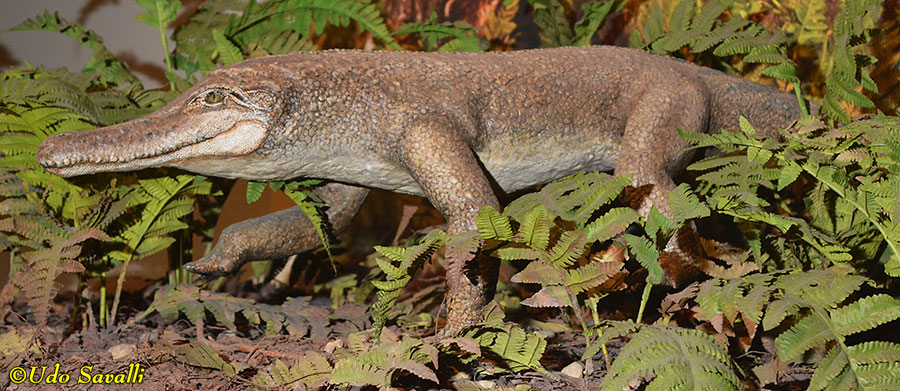
|
|
|










































